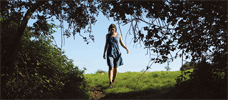Reviews
Don Argott
USA, 2009
Credits
Review by Mike D’Angelo
Posted on 17 September 2009
Source 35mm print
Categories The 2009 Toronto International Film Festival
Like most film festivals nowadays, Toronto features a section devoted exclusively to documentaries. Real to Reel, they call it here. And as a general rule, the first thing I do each year when devising a tentative schedule is to cross just about every Real to Reel title off my list. Rarely do I even bother to investigate what any given doc is about before tossing it in the discard pile. Next!
Unfair? Probably. But while great documentaries continue to be made - Bus 174, Grizzly Man and My Kid Could Paint That have all placed on my top ten lists in recent years - the recent explosion in nonfiction filmmaking, driven in large part by ready access to cheap video cameras, has resulted in approximately 60 gazillion docs with no compelling reason to exist, except that somebody wanted to make a movie. “Why would this subject be well served by moving images?” is a question that doesn’t seem to occur to most docmakers, perhaps because very often the correct answer is “It wouldn’t.”
Case in point: The Art of the Steal, the only documentary I’ve watched at TIFF ‘09 thus far. (Its inclusion in the ultra-selective New York Film Festival swayed me.) Directed by Don Argott (Rock School), it examines the allegedly tragic fate of the Barnes Foundation, a remarkable collection of post-impressionist and early-modernist art currently located in Merion, Pennsylvania, a suburb of Philadelphia. Assembled in the 1920s by Dr. Albert Barnes, an iconoclast with no love for most of his peers in the art world, it’s been eyed hungrily by various cultural and business interests ever since 1951, when Barnes was killed in an auto wreck; The Art of the Steal details the machinations employed to circumvent Barnes’ will, which stipulated that the collection could never be moved. Unless something happens in the meantime, the Barnes Foundation will move to Philadelphia next year.
First of all, Argott and his collection of talking heads make a pretty feeble case for this hijacking as the artistic crime of the century. Yes, Barnes is probably rolling in his grave, and while one could argue (though the film barely does) that masterpieces like Matisse’s “Le bonheur de vivre” and Cezanne’s “Nature morte au crane” deserve to be seen by a wider audience than tiny Merion can accommodate, on the whole I’d prefer to see the collection remain where it is. But moving everything 4.2 miles is hardly the desecration this movie suggests. The new space will even replicate Barnes’ idiosyncratic layout, in which works are grouped aesthetically rather than by period or artist, so that visitors will have more or less the same experience they would have in the original locale. And while various Philadelphia interests will surely make money from this venture (thanks largely to increased tourism), it’s not as if anyone is being impoverished—the art itself still belongs to the same Foundation it has since 1951, though the number of trustees has tripled in recent years.
Still, even if Argott had a strong case, it’s not a case that needed to be made on film (or video). Apart from the paintings, there’s nothing to look at here—like most mediocre docs, The Art of the Steal just rounds up a bunch of interview subjects and sits them down to yak it up in front of a generic backdrop, though Argott does his best to jazz things up via snappy editing and some archival footage. The only reasons to watch this movie rather than read John Anderson’s Art Held Hostage: The Battle Over the Barnes Collection, which tackles the whole brouhaha in far more depth, are illiteracy and laziness. The late Gene Siskel used to ask whether a given film was more interesting than watching the actors sit down and have lunch together; when it comes to most docs these days, ask yourself, before you buy a ticket, whether you’d rather read a book or lengthy magazine article on the same subject. Does cinema bring something to the material that a combination of words and stills couldn’t possibly convey? If not, why bother?
More The 2009 Toronto International Film Festival
-

Huacho
2009 -

A Serious Man
2009 -

Hadewijch
2009 -

Soul Kitchen
2009 -

The Bad Lieutenant: Port of Call New Orleans
2009 -

The Art of the Steal
2009 -

The Ape
2009 -

Trash Humpers
2009 -

My Son, My Son, What Have Ye Done
2009 -

L’Enfer de Henri-Georges Clouzot
2009 -

Father of My Children
2009 -

Police, Adjective
2009 -

Lebanon
2009 -

Chloe
2009 -

The Disappearance of Alice Creed
2009 -

Lourdes
2009 -

Ondine
2009 -

Life During Wartime
2009
We don’t do comments anymore, but you may contact us here or find us on Twitter or Facebook.



